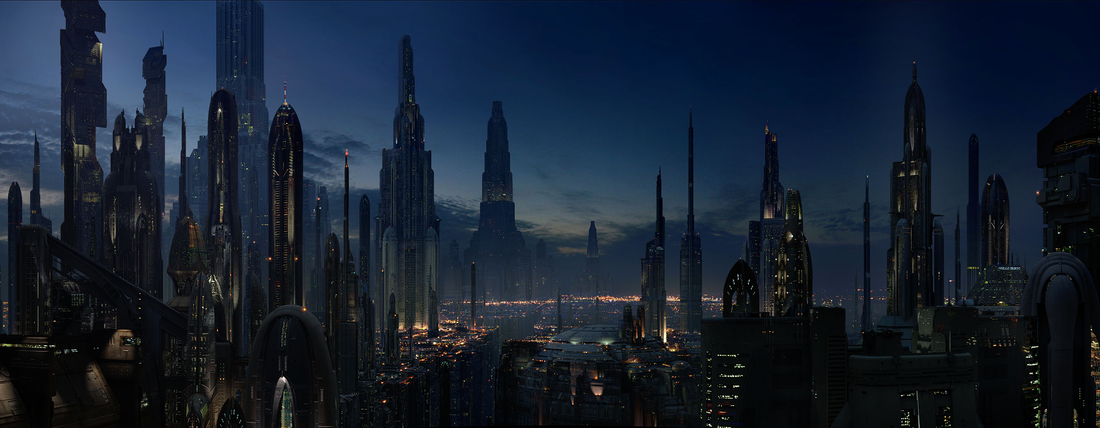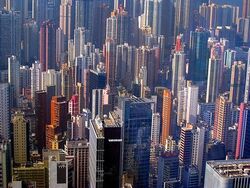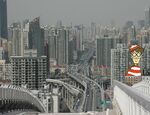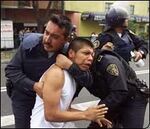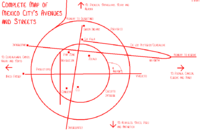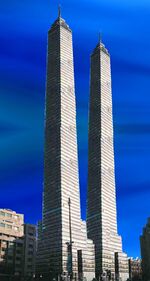Mexico City
Ciudad de Mexico, Distrito Federal
| Motto | Viva la cheve |
|---|---|
| Established | 1325 by the Aztecs (the good guys), then destroyed and rebuilt in 1521 by the Spanish (the bad guys) |
| Government Type | Democratically oppressed |
| Head of Government | El más chingón |
| Location | Mexico (sometimes Sweden, it tends to move around) |
| Population | 40-point-something million. In spanish: Un putamadral y chingomil chorrocientos millones de cabrones |
| Size | 783 mi² / 2,027.96 km² |
| Major Newspaper | Periódico de Los Pinos |
| Anthem | Sábado Distrito Federal by Chava Flores |
| Sports Teams | El PRI, El PAN, El Verde, El PRD (all soccer) |
| Website | In construction |
Mexico City, (Spanish, La Ciudad de México, Chilangolandia, Guachinton, D.F., De-Fiéndete, El Defe, or La Capirucha as it is known to Mexicans), is the capital of Los Estados Unidos Mexicanos, more commonly known as Mexico to non-Mexican speaking people. It is located in the center of Mexico and often difficult to find due to the wall of thick smog that clouds it. According to any Mexicans you meet, Mexico City is the largest and biggest city in the world. It is also the bestest, biggest, greatest, coolest, largest, maximalist, mostest, mas chingona, paramountificalist, superlative, supremoest, the end*, way tops, topmost and utmost. An antonym for Mexico city would be "smallest." According to a recent survey of barelies, the population of Mexico City is 25,000,000. The odds of getting robbed in Mexico City are equal to the odds of finding an Indian infesting Canada. 99/100
History[edit]
Mexico City wasn’t always your typical urban monstro-city it is today. At some point in time, before the name Mexico City was even coined, what it is today Mexico City used to be a breathable fresh-aired valley surrounded by vegetation, exotic animals, an impressive volcano with a snow cap during winters, and just in the middle of the valley, there was a huge lake just about the same size as the Great Lakes of Michigan. Along came man and saw this marvel of nature and fell in love with it. Man, or more plurally correct, men of the Aztec Empire, which ruled the western hemisphere at the time, named this lake after their God of Water, Tenochtitlan. El Niño de Tocha, which means “the child of Tocha”--no one knows what Tocha means-- who was Emperor of the Aztecs at the time thought Lake Tenochtitlan was a waste of land and gave an order that changed the history of the Democratic Republic of the United States of Mexicans, as we known it. The water of Lake Tenochtitlan was pumped out and the dried lake was later filled in with fresh soil. All of the vegetation was burned in a big fire that lasted 6 months. The Aztecs believed anything green was the work of the devil. Ironically, the color green has become the symbol of present-day Mexico and it is associated with anything Mexican. All of the exotic animals were slaughtered since the Aztecs believed animals were inferior creatures with no soul. The Aztec Empire collapsed after the Great Earthquake of 1989. This earthquake measured 8.9 on the Aztec Scale. A new Empire erupted in this now deserted land. The empire came to be known as Partido Revolucionario Institucional, (English, Institutional Revolutionary Party, acronym, PRI) The PRI, would ruled for the next 1000 years. In the years that came, people started moving to this new land in search of a better life. The PRI would promise this new comers that for the price of a small donation called “impuesto”, which means tax, they would be given land, goods, and services to make their lives better.
In 1521, Mexico City was officially declared as a municipality with a population of 2 million, the total population of the country at the time as everyone in United States of Mexicans had move to Mexico City. The city continued to grow as people built more and more people came in. In 1810, when the United States of Mexicans won its independence from Spain, a special place in Mexico City was chosen to build the residence of the president of the nation. This place was named Los Pinos, which means The Pines. Los Pinos is the official resident of the president just like the White House is the official residence of the president in the United State of the North American Continent. Only high-ranking officials, foreign diplomats, and film and television celebrities are welcomed at Los Pinos. Regulars citizens are not welcomed.
Present-Day Mexico City[edit]
Population[edit]
A recent census on the population of the Democratic Republic of the United States of Mexicans, estimated-- and note: this was just an estimate and it’s not be taken as an official factual figure- that the population of the aforementioned nation is somewhere closely but slightly below the population of its northern neighbor and life-long friend the United States of the North American Continent. After executing a very complicated mathematical equation, the Office of Demographic Aspects of the Republic, concluded that Mexico City has somewhere close and perhaps slightly above of 40 point something million inhabitants (Cómo 40 millones de chilangos huevones - cifra aproximada). An exact prudent number of people living in the capital is unknown due to the extreme population growth rate. This drastic phenomenon is known as the Mexican Movement. Also, due to the fact that in Mexico there is no exact of anything and it is considered politically incorrect to attempt to keep exacts figures of anything. Audits are forbidden all over Mexico.
Government[edit]
Under the current system of government of the United States of Mexicans, Mexicans are under the belief that every six years, the “change” is coming. This “change” collides with the election of a new president for the country. The way this works is by making Mexicans believe that even though things are bad right now, worry not, things will get better as soon as they get a new president. This principle starts in Mexico City, the seat of government of the nation. The mayor of Mexico City is known as the Chief of Government, or el Jefe. El Jefe is in charged that the 40 point something million Mexicans are oppressed and therefore incapable of rising up in arms against this oppression that has been followed for the last 75 years. NOTE: Prior to 1931, Mexicans lived under another oppression which was stormed down by the Mexican Revolution to be replaced by the current oppression.
Political Figures & Achievements[edit]
One notorious Jefe was Andrés Manuel Lopez Obrador, (English, Andrew Manual Lofish Laborer) Lopez Obrador came to power during a time in which Mexico City was being plagued by a pattern of crime, poverty, murder, corruption, debt, and a whole new variety of political, social-economic insecurity that was eating up its residents. Lopez Obrador promised the “chilangos” as Mexico City residents are known, that if he was elected mayor of their city, he would make sure there was bread on their table and he would immediately order the construction of a new high-capacity vehicular mass-transit freeway system similar to the freeway system in Los Angeles. This marble of architectural advancement came to be known as “el Segundo Piso”, which literally means “the second floor” but is more adequately translated as the “multi-lane double deck expressway“. This double deck expressway was ambitioned by Lopez Obrador since the beginning of his mayoral campaign. The whole purpose of this epic sized multi-billion pesos useless project was to relieved the already heavily-congested roadways of the capital.
El Sengudo Piso turned out to be a big success. While no improvements were made to the flow of traffic, everyday commuters now had option of being stuck in traffic in the boring and smog-infested lower level of the expressway, or enjoy of a breathtaking view of the smog-infested city from the second level of the expressway.
Immediately after the completion of the second floor, Lopez Obrador stepped down from office as another government failure and announced that he would now run for president of the nation, which is a common trend among corrupted Mexican politicians.
The Smell[edit]
This is an intense point of Mexican pride. Yearly, Mexico city hold the La Féstival Dé Suciédad. For days beforehand the nation's farmers force feed their livestock (Cows, pigs, chickens, llamas and geese) laxatives. The fecal matter is then collected and shipped to the capitol by truck and deposited in the city's center. The joyous citizenry, many wearing nothing more than goggles, throngs the streets and proceed to having a "feces fight" for the next 8 days. Citizens describe the resulting smell as "El Olor de la Alegría" (The Smell of Joy).
Law Enforcement[edit]
Mexico City follows a strict “Way of the Gun” judicial policy which means that if you want something, you take it from someone else by threatening them with a firearm. Surprisingly enough, the rape rate in Mexico City if very low but the armed robbery and kidnapping rate is at its highest. Mexico City residents and visitors can be robbed and kidnapped at any moment and any given time of the day. Even after hours, weekends, and holidays. It is illegal for law-abiding citizens in Mexico to own a weapon, this being any kind of weapon, including pocket knives and baseball bats, if intended to used as weapons but criminals are not prosecuted for utilizing a weapon in the course of committing an assault upon a law-abiding citizen. Strangely enough, the laws of the United States of Mexicans are similar and almost identical to the laws of the United States of the North American Continent but with the different that people are not legally required to follow them. Police Officers in Mexico City only respond to the calls of high-ranking political figures and film and television celebrities. Despite popular disbelief, the 911 emergency response system does exist in Mexico. This number is exclusively available only to wealthy residents, political figures, and film and television celebrities. Regular citizens can dial 066 and should expect no response.
Crime Prevention[edit]
There is no such of thing as crime prevention in Mexico City or anywhere in Mexico, for that matter. There is what it is known as Crime Vention, which means crime will happen, as well as Crime PostVention, that means that if crimes happened, well, it happened.
Transportation[edit]
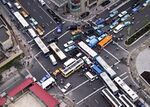
Mexico City counts with one of the most advanced and reliable subway systems in the world, however, its streets and highways are another story. The car population in the capital is 100% and its odd style of highway construction and the lack of road rules and licenced drivers puts Mexico City right next to Los Angeles in traffic jams and horrific traffic of legendary proportions. Urban legend tells that the reason why Mexico City suffers of such horrific traffic jams is because of the millions of drivers that have no knowlegde of driving except push gas pedal and turn and no road rules and Volkswagen Beetles turned to taxis, which half of them are pirated versions created by people who refuse to pay the fees for a taxi operation permit. Other legends say it's because of the badly-funded and badly-maintanced roadway system in a bureaucratic and corrupt government system where all available funds go to the pockets of high-ranking officials and their henchmen below them. These theories are debated everyday on the Mexican TV networks.
- El Metro, as the subway is known in Mexico City, can take you anywhere in the capital and its vicinities. El Metro successfully handles more than 20 million users travel around the city and buy pirated CDs. it is also the most popular place to stab blacks,whites,and asians. some mexicans have also been stabbed but mostly for disputes over tacos and such. the subway cars are constantly packed with muggers, pickpockets, and druggies.
- El Pesero or Microbus, as city buses are known in the city, are top of the line Mercedes Benz buses that for the price of being squished like sardines, riders can be transported to virtually any place in the city. El Pecero means “fish tank” and are nicknamed so because they are loaded with passengers at least 10 times beyond their maximum seating occupancy. Microbus means “microbus” because they are just slightly bigger than the short school buses we’re all familiar with. For the sake of sarcasm, microbuses are loaded with passengers twice as much as the pecero buses. Wallet-, boob-, penis-, and ass-grabbing is common in this buses as riders must rub. Bus drivers are usually bad-spoken, tooth-missing individuals who will demand an old, helpless lady to give up her seat to an attractive woman.
- Taxis in Mexico City are usually tiny green and white Volkswagon Beetles, of the 1950s variety (which were produced here beyond the year 2000). Like everything else in Mexico City, they are often pirated. Much to the dismay of their clients, pirate taxi drivers have a penchent for wielding hand guns and robbery.
Mexico City also counts with the world's first double deck freeway system, known as "The Second Floor". The only thing this system lacks is connecting interchange ramps between the freeways. This forces drivers to get out of one freeway and use a surface road to get onto another freeway creating horrible traffic jams in residential neighborhoods.
- El Periférico, as the freeways are known in Mexico City, is a multi-lane freeway system that successfully handles millions of commuters as they go on their journeys to contribute to the already devastating problem of excess pollution in the capital. For this problem, the city government created a system called the “Hoy No Circula” to relieve the traffic congestion. Hoy No Circula means “Today you Can't Drive” and its essential purpose is to force every motor vehicle driver to leave their vehicle at home one day a week and carry on their daily obligations by public transportation, carpool in a vehicle which can be driven that day, ride a bicycle, or walk. This system successfully cut down the traffic population in the roadways by 14 percent everyday but created a major problem as this 14 percent of the population who could not operate their vehicle tried to used public transportation and the already poorly run public transportation system could not handle the extra load. This forced many to be late for work, school, church, jury duty, and other appointments creating a devastating clash in the economy, only compensated by the rise of " hoy no circula"-day car sales.
Visitors and people wishing to get out of Mexico City for once, can do so by air.
- El Aeropuerto Internacional de la Ciudad de México, which with no effort and linguistic talent means Mexico City International Airport, is the biggest airport in Mexico and the hub for some major Mexican airlines. From here, travelers can escape the devastating effects of prolonged exposure to vehicle exhaust. Arriving adventurers who dare to enter Mexico City can appreciate the breathtaking views of this immense mess cramped in a basin with hopes without escape, as they descend on final approach. On his first visit to Mexico City, Michael Jackson confused Mexico City with Paris as he glared at the vast and endless city lights as they tucked in the horizon when his jet was preparing for landing and was banking to align itself with the runway. He confused the Latin American Tower with the Eiffel Tower and it wasn’t until the kid he was traveling with, who told him that they were in fact flying over Mexico City, that he stopped moon walking.
The Infamous Speed Bumps[edit]
Mexico City is world-wide known for its impressive speed bumps with heights of astronomical proportions. These marvels of roadway engineering was invented by Franco Tope, former director of the city's Department of Transportation. He named his invention after him (tope means speed bump in Mexican) Franco Tope was looking for a way to help the city save millions of Mexican Pesos in signal lights and stop signs' costs. After scratching his head a few times, the idea of the speed bumps lit his bulb. Speed bumps are found all over the city: in every intersection, corner, half a block, one third of a block, one fourth of a block...
Speed bumps serve 3 purposes in Mexico City:
- Help stop the vehicle in case conventional braking system fails.
- Test the design and performance of suspension in vehicles and this way drivers know what type of car not to buy next time.
- Teach people how to drive on first and second gear on manual transmission cars. Mexico City residents know the strategy by heart: go up with speed, break, and go down slowly. Sort of like having sex for them!
Economy[edit]
Mexico City has a free market-oriented economy. In this economy, politicians and celebrities control the economy. They joy of a very upscale, lavish lifestyle at the cost of millions of hard working citizens. In this free market-oriented economy, anyone can become a politician or celebrity so as long you are a relative or friend of already politicians and celebrities who have worked a life in the field for many generations before them. If this is not the case, they will arrange your assassination in broad daylight in front of thousands of witnesses since in Mexico it is customary to murder those who stand in your way.
Districts & Neighborhoods[edit]
Mexico City's neighborhoods follow trends similar to cities in the United States of the North American Continent. Its neighbors contrast each other to reflect their themes:
- La Zona Rosa, (eng. the Pink Zone), is Mexico City’s center of night entertainment. This vibrant and colorful neighbor is the equivalent of Time Square of New York City or Montmartre of Paris. Here visitors and locals alike will find a whole variety of entertainment including whorehouses, titty bars, hourly motels, prostitutes, and anything to meet your family needs, is the Hillcrest, Castro, or West Hollywood of Mexico City. This neighborhood is exclusively gay and anyone entering should be conducting strict gay business.
- Azcapotzalco (eng. Ass-kah-pots-all-koh) This is the horribly compact lower middle class area of the city crowded with endless rows of high-rise apartments, a great place for people with suicidal ambitions.
- San Ángel, (eng. Saint Angel), is Mexico City’s film and television district. This is the Hollywood of Mexico. Televisa and TV Azteca are the two major film and television studios and rivals of each other due to their administrators’ political affiliations.
- The Zocalo (eng. Downtown, city centre) can be considered one of the most beautiful centres in the whole world. Unfotunetly, millions of street vendors fill the streets making it impossible to admire the beautiful buildings and statues.
- Polanco (eng. pull-an-go) If your plan is to shop, Polanco is where you want to be. The area offers only the best named brand stores from Louis Vutton to Armani Exchange to Versace to Lacoste to Gucci etc. Masaryk is the street where you will find these stores, this street is often related to 5th avenue in NY. Beware traffic, Polanco suxs when it comes to traffic, and also watch out, the area is flooded with jews and asians.
- Xochimilco, (eng. Zosheemilko), is the Venice, Italy, of Mexico. Located in the southern region of the capital, this jewel is composed of numerous canals and the only different with Venice from Italy is that here the Mariachi replaces the fiddler on gondola.
- La Condesa, (eng. the Countess) This upscale, high-class neighborhood is the home to many politicians, celebrities and wannabes while working in the city.
- Tepito, (eng. Thepeetho, a.k.a "El Barrio Bravo de Tepito"), is the L.A. alleys of Mexico City, only bigger. This neighborhood is one big flea market frequented by visitors and locals alike looking to save money on knockoff named-brands, generic prescription drugs, generic hard drugs, and pirated films and music.
- Coyoacán, (eng. Coyote Ugly) It is well known for its "hippyness".
- Santa Fe, (eng. Saint Faith), is the modern, high tech area of Mexico City. Here you will see some of the most modern buildings in the world. It is considered the CBD of Mexico City. Santa Fe is barely new (before it used to be a huge waste dump) and it is a great place to go if you wish to escape the sometimes awful and nasty rest of the city.
- Nezahualcoyotl, (eng. Neza-oolkojoth, a.k.a "Neza York", "MiNezota Querida"), is the Inglewood, Compton, or South Central of Mexico City. When entering this neighborhood, one should be heavily armed, heavily armored, and carry a shoot-first, ask-questions-later policy.
- Las Lomas (eng. The hills) The beverly Hills of Mexico City. The complete opposite of Nezahualcoyotl. Here you will find huge ass mansions with huge ass walls which sucks because you cannot see the huge ass mansions. Here you will find the best cars, women, men, clothes, kidnappers and robbers the city has to offer
- El Barrio Chino, (eng. Chinatown), no city would be complete without Chinatown and Mexico City is no exception. This is an Asian-oriented neighborhood where only Mexicans who look Chinese and have hade there wieners shortened to appear more asian are allowed to go in.

